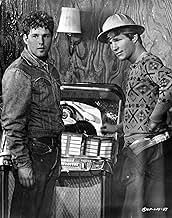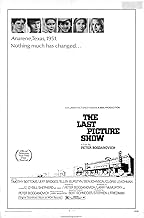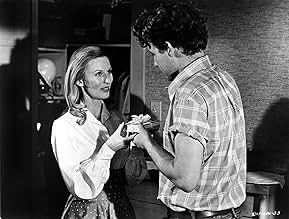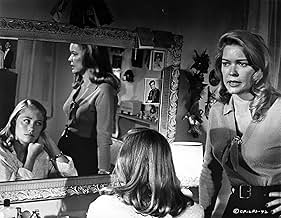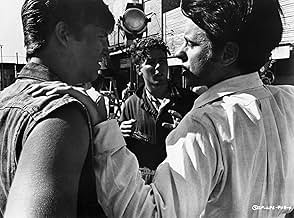1951: Eine Gruppe von Highschool-Schülern wird langsam erwachsen, allerdings in einem ziemlich öden und verkümmerten Örtchen in Westtexas, der langsam dahinsiecht, sowohl was die Kultur, abe... Alles lesen1951: Eine Gruppe von Highschool-Schülern wird langsam erwachsen, allerdings in einem ziemlich öden und verkümmerten Örtchen in Westtexas, der langsam dahinsiecht, sowohl was die Kultur, aber auch was die Wirtschaft betrifft.1951: Eine Gruppe von Highschool-Schülern wird langsam erwachsen, allerdings in einem ziemlich öden und verkümmerten Örtchen in Westtexas, der langsam dahinsiecht, sowohl was die Kultur, aber auch was die Wirtschaft betrifft.
- 2 Oscars gewonnen
- 19 Gewinne & 22 Nominierungen insgesamt
- Charlene Duggs
- (as Sharon Taggart)
Handlung
WUSSTEST DU SCHON:
- WissenswertesCybill Shepherd was cast with the option of backing out of her nude scenes if she so desired. She only agreed to do them after asking the opinions of three female costars - Cloris Leachman, Ellen Burstyn, and Eileen Brennan, who all thought she should do them.
- PatzerThe lavalier mic on Duane's tie is visible during the graduation scene.
- Zitate
Sam the Lion: You boys can get on out of here, I don't want to have no more to do with you. Scarin' a poor, unfortunate creature like Billy just so's you could have a few laughs - I've been around that trashy behavior all my life, I'm gettin' tired of puttin' up with it. Now you can stay out of this pool hall, out of my cafe, and my picture show too - I don't want no more of your business.
- Alternative VersionenSpecial edition includes seven minutes of footage not included in the original release.
- VerbindungenFeatured in The Last Picture Show Re-Release Promo (1971)
- SoundtracksCold, Cold Heart
(uncredited)
Written by Hank Williams (as Hank Williams Sr.)
Performed by Tony Bennett
Bogdanovich's love affair with film is undeniable, though it has, in the past three decades, yielded far more perplexing misfires (The Cat's Meow, At Long Last Love, Nickelodeon) than unqualified successes. That said, The Last Picture Show is an extraordinary accomplishment and worthy of its place in the list of great films of the 1970s.
1971's other important films (Friedkin's The French Connection, Pakula's Klute, Kubrick's Clockwork Orange) are loud, angry, violent and contemporary in-your-face reflections of a society in which rage and nihilism, engendered by Vietnam and the growing discontent over government corruption, is the currency of communication. The uncertainty coursing through the veins of American pop culture also begat in equal, if not equally graphic, measure a palpable sense of sorrow at the destruction of a simpler way of life (no matter how "true" that memory may be).
Like Jewison's Fiddler on the Roof and Altman's McCabe & Mrs. Miller, The Last Picture Show is a powerful and poignant evocation of the death of a community and a way of life. Thematically rich and imbued with Bogdanovich's remarkable knowledge and passion for film, the movie works on a dazzling number of levels; and Bogdanovich's use of nostalgia and traditional, archetypal genre conventions both enriches the movie and compounds the heartbreaking loss at the heart of the story.
His deft handling of a cast comprised of then (largely) unknowns (Bridges, Bottoms, Shepherd) is first-rate and he draws forth superb, often sublime performances from everyone (in particular, Johnson, Burstyn and Leachman). There isn't a false note or a misstep in the movie and there is a naturalness here that is not easily achieved or earned. The great production design (by Bogdanovich's then wife and partner Polly Platt whose contributions to his work and her subsequent involvement in the best works of James L. Brooks should not go underestimated) and the achingly beautiful cinematography by the late Robert Surtees are vital to the success (emotionally, intellectually, thematically) of the film.
The Last Picture Show is a truly rare work of surprising depth and emotional resonance; and the heartache for a time and place forever gone and the desperate and quiet struggles of its very real, very human denizens is matched only by the sorrow found in contemplation of Bogdanovich's Icarus-like fall from such exalted heights.
Top-Auswahl
Details
- Erscheinungsdatum
- Herkunftsland
- Sprache
- Auch bekannt als
- La Última Película
- Drehorte
- 605 South Ash Street, Archer City, Texas, USA(high school)
- Produktionsfirmen
- Weitere beteiligte Unternehmen bei IMDbPro anzeigen
Box Office
- Budget
- 1.300.000 $ (geschätzt)
- Bruttoertrag in den USA und Kanada
- 29.133.000 $
- Weltweiter Bruttoertrag
- 29.146.255 $
- Laufzeit1 Stunde 58 Minuten
- Farbe
- Sound-Mix
- Seitenverhältnis
- 1.85 : 1
Zu dieser Seite beitragen






